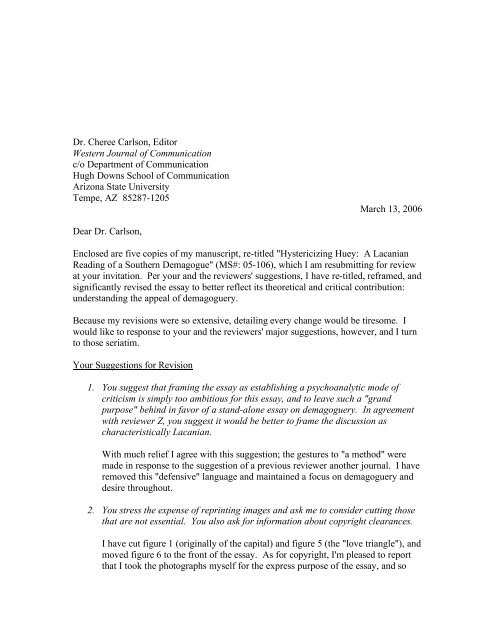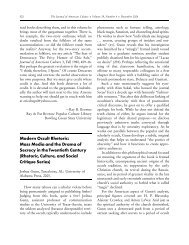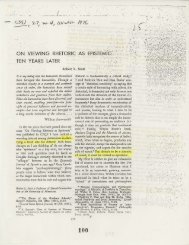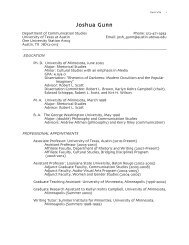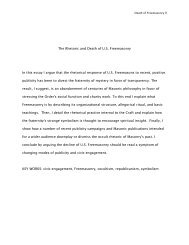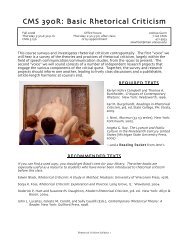Here is a draft of that cover letter
Here is a draft of that cover letter
Here is a draft of that cover letter
You also want an ePaper? Increase the reach of your titles
YUMPU automatically turns print PDFs into web optimized ePapers that Google loves.
Dr. Cheree Carlson, Editor<br />
Western Journal <strong>of</strong> Communication<br />
c/o Department <strong>of</strong> Communication<br />
Hugh Downs School <strong>of</strong> Communication<br />
Arizona State University<br />
Tempe, AZ 85287-1205<br />
March 13, 2006<br />
Dear Dr. Carlson,<br />
Enclosed are five copies <strong>of</strong> my manuscript, re-titled "Hystericizing Huey: A Lacanian<br />
Reading <strong>of</strong> a Southern Demagogue" (MS#: 05-106), which I am resubmitting for review<br />
at your invitation. Per your and the reviewers' suggestions, I have re-titled, reframed, and<br />
significantly rev<strong>is</strong>ed the essay to better reflect its theoretical and critical contribution:<br />
understanding the appeal <strong>of</strong> demagoguery.<br />
Because my rev<strong>is</strong>ions were so extensive, detailing every change would be tiresome. I<br />
would like to response to your and the reviewers' major suggestions, however, and I turn<br />
to those seriatim.<br />
Your Suggestions for Rev<strong>is</strong>ion<br />
1. You suggest <strong>that</strong> framing the essay as establ<strong>is</strong>hing a psychoanalytic mode <strong>of</strong><br />
critic<strong>is</strong>m <strong>is</strong> simply too ambitious for th<strong>is</strong> essay, and to leave such a "grand<br />
purpose" behind in favor <strong>of</strong> a stand-alone essay on demagoguery. In agreement<br />
with reviewer Z, you suggest it would be better to frame the d<strong>is</strong>cussion as<br />
character<strong>is</strong>tically Lacanian.<br />
With much relief I agree with th<strong>is</strong> suggestion; the gestures to "a method" were<br />
made in response to the suggestion <strong>of</strong> a previous reviewer another journal. I have<br />
removed th<strong>is</strong> "defensive" language and maintained a focus on demagoguery and<br />
desire throughout.<br />
2. You stress the expense <strong>of</strong> reprinting images and ask me to consider cutting those<br />
<strong>that</strong> are not essential. You also ask for information about copyright clearances.<br />
I have cut figure 1 (originally <strong>of</strong> the capital) and figure 5 (the "love triangle"), and<br />
moved figure 6 to the front <strong>of</strong> the essay. As for copyright, I'm pleased to report<br />
<strong>that</strong> I took the photographs myself for the express purpose <strong>of</strong> the essay, and so
eprinting them should not be an <strong>is</strong>sue (if accepted for publication, I'm uncertain<br />
if they will need to be captioned with credits).<br />
Reviewer X's Suggestion<br />
3. The first objection reviewer X voices <strong>is</strong> at the level <strong>of</strong> method: the theoretical<br />
approach taken uses the case study <strong>of</strong> Long, not so much to illuminate a<br />
h<strong>is</strong>torically specific d<strong>is</strong>course as much as further prop the theory. In other words,<br />
I see what I want to see because my reading prefigures the d<strong>is</strong>course with<br />
psychoanalytic categories.<br />
Th<strong>is</strong> <strong>is</strong> an important and valuable insight <strong>that</strong>, I regret, no rev<strong>is</strong>ion could<br />
overcome without substantially extending the d<strong>is</strong>cussion. Within the overall<br />
context <strong>of</strong> the reviewer's remarks, the object seems rooted in a particular<br />
methodological (and ideological) commitment: <strong>that</strong> one approaches texts or<br />
d<strong>is</strong>course without preconceived notions or categories, and then, on the bas<strong>is</strong> <strong>of</strong><br />
"close reading" or working through the intricacies <strong>of</strong> the d<strong>is</strong>course, selects <strong>that</strong><br />
theoretical perspective <strong>that</strong> the d<strong>is</strong>course seems to recommend (I recall th<strong>is</strong> <strong>is</strong><br />
sometimes referred to as the "organic" approach to critic<strong>is</strong>m).<br />
Although I was trained in th<strong>is</strong> approach, th<strong>is</strong> essay comes at d<strong>is</strong>course from a sort<br />
<strong>of</strong> "mid-level" theoretical approach akin to genre critic<strong>is</strong>m (and therefore suffers<br />
similar objections). In my view, Lacanian categories have more to do with<br />
Burke's understanding <strong>of</strong> "form" than termin<strong>is</strong>tic screens: on the bas<strong>is</strong> <strong>of</strong> clinical<br />
experience psychoanalysts have seen a number <strong>of</strong> "patterns" or things occurring<br />
among patients <strong>that</strong> yield pleasure. From th<strong>is</strong> empirical bas<strong>is</strong>, a number <strong>of</strong><br />
psychical structures were defined and d<strong>is</strong>cerned and amended over time. The<br />
structures <strong>of</strong> neuros<strong>is</strong>, like <strong>that</strong> <strong>of</strong>, say, a genre, seem to evince a repeated<br />
movement (or seeming causation)—but the particularities <strong>of</strong> th<strong>is</strong> movement, as<br />
well as their unique form <strong>of</strong> expression, differ from one individual or d<strong>is</strong>course<br />
from the next. So, to borrow Edwin Black's terms, "The [psychoanalytic critic's]<br />
training and experience instruct him in where to look, but not in what to see." My<br />
dec<strong>is</strong>ion to use Lacanian concepts to understand Long's appeal came after I saw<br />
him deliver a speech on a video documentary; I immediately thought he was<br />
"hysterical," and originally my analys<strong>is</strong> pursed <strong>that</strong> idea. After studying Long, I<br />
changed my mind to the opposing pole: in th<strong>is</strong> sense my familiarity with<br />
psychoanalys<strong>is</strong> taught me where to look, just not what I was going to see.<br />
In short: th<strong>is</strong> objection <strong>is</strong> the objection <strong>that</strong> many psychoanalytic approaches to<br />
rhetorical phenomena have and will likely meet. It <strong>is</strong> my hope <strong>that</strong> by abandoning<br />
the specification <strong>of</strong> "method" and focusing, instead, on how the notion <strong>of</strong> desire<br />
better explains the appeal <strong>of</strong> demagogic rhetoric, I can persuade reviewer X to "go<br />
along for the ride" even if she d<strong>is</strong>agrees with my failure to let the text dictate the<br />
method. Indeed, a psychoanalytic approach to texts <strong>of</strong>fers an alternative to the<br />
"organic" approach, while not abandoning the necessity <strong>of</strong> h<strong>is</strong>torical specificity<br />
and context.
4. A related objection <strong>that</strong> reviewer X voices <strong>is</strong> <strong>that</strong>, ins<strong>of</strong>ar psychoanalys<strong>is</strong> <strong>is</strong><br />
primarily a clinical technique aimed at managing mental illness, it <strong>is</strong><br />
inappropriate to transfer its insights into non-clinical settings (e.g., cultural<br />
readings)—at the very least, because it <strong>is</strong> unfair to the real, h<strong>is</strong>torical Huey Long.<br />
Although I understand the bas<strong>is</strong> <strong>of</strong> th<strong>is</strong> objection and recognize why some readers<br />
would agree with it, I attempt to respond in the essay by stressing my focus <strong>is</strong> on<br />
the figure <strong>of</strong> Long in h<strong>is</strong> d<strong>is</strong>course, and in texts about h<strong>is</strong> d<strong>is</strong>course and h<strong>is</strong> figure.<br />
In other words, my analys<strong>is</strong> <strong>is</strong> prem<strong>is</strong>ed on a d<strong>is</strong>tinction between the real,<br />
biological Long (e.g., <strong>that</strong> person who would submit to analys<strong>is</strong>), and h<strong>is</strong><br />
representation. No one has access to the "real" Long. Perhaps what recommends<br />
a Lacanian approach, above others, <strong>is</strong> <strong>that</strong> it makes d<strong>is</strong>course and the symbolic<br />
prior to the subject (and in th<strong>is</strong> sense, Long as a figure <strong>is</strong> an effect <strong>of</strong> d<strong>is</strong>course).<br />
5. Finally, the reviewer calls for more "evidence" in support <strong>of</strong> the argument <strong>that</strong><br />
demagogic rhetoric evinces the obsessive/hysteric dialectic.<br />
To th<strong>is</strong> end I have added ____ and blank _____ to pp. etc.<br />
Reviewer Z's Suggestions<br />
6. Reviewer Z first recommends abandoning the larger project <strong>of</strong> a psychoanalytic<br />
critic<strong>is</strong>m in favor <strong>of</strong> a sustained focus on demagogic rhetoric. As a corollary, she<br />
also suggests <strong>that</strong> the attempt to explain contemporary manifestations <strong>of</strong><br />
demagoguery (e.g., Bush and Clinton) be abandoned, since there <strong>is</strong> simply no<br />
room for it.<br />
7. Second, th<strong>is</strong> reviewer suggests <strong>that</strong> the argument needs to be brought into sharper<br />
focus: ins<strong>of</strong>ar as most rhetorical acts stimulate the desiring <strong>of</strong> the audience, what<br />
<strong>is</strong> particularly unique about demagogic rhetoric?<br />
8. Third, the reviewer recommends <strong>that</strong> the "tortured" explication <strong>of</strong> need, demand,<br />
and desire (pp. ) be replaced with Joan Copjec's elaboration in Read My Desire:<br />
Lacan Against the H<strong>is</strong>toric<strong>is</strong>ts.<br />
9. Fourth—and closely related to the previous objection—the reviewer suggests <strong>that</strong><br />
the d<strong>is</strong>cussion <strong>of</strong> desire seems to abandon its "object-less" movement in Lacan's<br />
work, which stresses <strong>that</strong> desire <strong>is</strong> its own end (not to be sat<strong>is</strong>fied). She d<strong>is</strong>agrees<br />
therefore with my assertion <strong>that</strong> the audience-as-hysteric "never gets what it<br />
wants" because what it wants <strong>is</strong> "nothing final, certain, sure."<br />
I agree with th<strong>is</strong> point and have rev<strong>is</strong>ed accordingly. On pp. I remark, again, the<br />
important role <strong>of</strong> the ruse here, the m<strong>is</strong>take <strong>that</strong> a love object <strong>is</strong> what the audience<br />
things <strong>that</strong> it wants when, in fact, the
10. Reviewer Z urges <strong>that</strong> I incorporate the work <strong>of</strong> James McDaniel and others <strong>that</strong><br />
help to lend support to the argument <strong>that</strong> demagogues are successful and<br />
persuasive only to the extent <strong>that</strong> audiences derive pleasure from never getting<br />
what they are prom<strong>is</strong>ed.<br />
To th<strong>is</strong> end I have ___.<br />
11. The reviewer says she was perplexed by my suggestion <strong>that</strong> Lou<strong>is</strong>ianian's gave<br />
Huey a monument <strong>that</strong> represented what he was to them. She suggests, rather,<br />
<strong>that</strong> they gave themselves "a substitute in the face <strong>of</strong> the loss <strong>of</strong> the big Other!"<br />
I agree with th<strong>is</strong> observation and have rev<strong>is</strong>ed my remarks to reflect th<strong>is</strong> reading.<br />
I think the confusion concerns my adoption <strong>of</strong> the perspective <strong>of</strong> the hysteric (an<br />
empathetic gesture).<br />
12. The final major rev<strong>is</strong>ion reviewer Z recommends concerns the collapse <strong>of</strong> the<br />
symbolic and the rhetorical.<br />
I have taken care in th<strong>is</strong> re-writing to emphasize the d<strong>is</strong>tinction (strictly speaking,<br />
for Lacan the domain <strong>of</strong> the rhetorical <strong>is</strong> tropology, understood as a logic <strong>of</strong><br />
movement, while the Symbolic <strong>is</strong> an order or reg<strong>is</strong>ter).<br />
12. Finally, the reviewer recommends <strong>that</strong> (a) I remove claims <strong>that</strong> posture or <strong>that</strong><br />
are unsubstantiated claims be removed; (b) I indicate a familiarity with the<br />
debate concerning whether Lacan did or did not jett<strong>is</strong>on a biological bas<strong>is</strong> for<br />
understanding sexuation, as not doing so announces a lamentable ignorance; (c) I<br />
rev<strong>is</strong>it Fink's d<strong>is</strong>cussion <strong>of</strong> obsession on p. 20 and eliminate the "love triangle"<br />
figure; and (d) sink the d<strong>is</strong>cussion <strong>of</strong> the phallus into the endnotes, as it "bogs<br />
down the flow <strong>of</strong> analys<strong>is</strong>."<br />
All <strong>of</strong> these suggestions were heeded and corrected in the text.<br />
_________________________<br />
As you can see, I took each <strong>of</strong> the reviewer's comments to heart and rev<strong>is</strong>ed and re-wrote<br />
the essay in light <strong>of</strong> them. Although I am doubtful <strong>that</strong> reviewer X can be swayed to<br />
accept psychoanalytic views, my hope <strong>is</strong> <strong>that</strong> these extensive rev<strong>is</strong>ions, keyed largely to<br />
the suggestions <strong>of</strong> reviewer Z, will recommend the essay has something to say <strong>that</strong> <strong>is</strong> new<br />
or <strong>that</strong> has not been addressed before. I look forward to hearing from you.<br />
Sincerely,<br />
Joshua Gunn<br />
Ass<strong>is</strong>tant Pr<strong>of</strong>essor<br />
University <strong>of</strong> Texas at Austin
Hystericizing Huey: A Lacanian Reading <strong>of</strong> a Southern Demagogue<br />
Joshua Gunn<br />
Department <strong>of</strong> Communication Studies<br />
University <strong>of</strong> Texas at Austin<br />
One University Station A1105<br />
Austin, TX 78712<br />
email: slewfoot@mail.utexas.edu<br />
phone: 512-471-3933<br />
MS HISTORY: An earlier version <strong>of</strong> th<strong>is</strong> paper was delivered at the 2004 Annual<br />
Meeting <strong>of</strong> the Southern States Communication Association in Birmingham, Alabama.<br />
AUTHOR NOTE: To be written when and if th<strong>is</strong> thing <strong>is</strong> ever accepted for publication.


